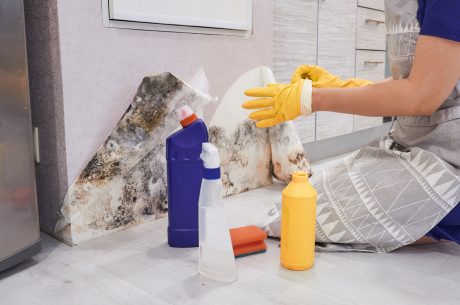In the tropical climate of Florida, persistent humidity and dampness make homes particularly susceptible to mold growth. This common household issue poses a serious risk to both your property’s structural integrity and the health of its occupants. Left untreated, mold can cause damage to walls, ceilings, and flooring and may trigger allergy symptoms and other respiratory problems. Therefore, it’s vital for homeowners in Florida to understand how to prevent mold growth, identify it early, and take appropriate remediation steps to maintain a healthy and safe environment.
Mold reproduces by releasing spores into the air, which is a natural part of our environment. However, when these spores find their way into your home and encounter ideal conditions – such as high humidity, warmth, and organic material to feed on – mold growth can quickly become a significant problem. Untamed mold growth not only compromises the structural integrity of your property but also exposes your family to potential health problems, such as irritated eyes, a runny nose, or even more severe respiratory issues. As Florida’s weather creates particularly inviting conditions for mold, it’s crucial that homeowners in the Sunshine State take proactive measures to prevent and address this concern.
Mold Prevention Strategies: Maintaining a Dry, Well-Ventilated Home
To effectively combat mold growth in your Florida home, prevention is crucial. Implementing the following prevention strategies will help keep mold at bay and maintain a healthy, mold-free environment:
1. Promote Proper Ventilation – Ensure good airflow throughout your home by opening windows, installing exhaust fans in kitchens and bathrooms, and using dehumidifiers in high-humidity areas, such as basements.
2. Control Indoor Humidity – Maintain indoor humidity levels below 60%, ideally between 30% and 50%, by using air conditioners and dehumidifiers and periodically checking humidity levels with a hygrometer.
3. Regular Maintenance and Inspection – Conduct routine checks for leaks in your home’s roofing, pipes, and appliances, and promptly repair any detected issues. Keep your gutters and downspouts clean and functional to prevent water accumulation and damage.
4. Use Mold-Resistant Materials – Choose mold-resistant building materials and products, such as paint, drywall, and insulation, when constructing or renovating your home.
Identifying Mold Growth: Signs to Look For
Early detection is key to preventing extensive mold damage. Keep an eye out for these telltale signs of mold growth in your home:
1. Visible Mold – Watch for dark spots, fuzzy patches, or discolored areas on walls, ceilings, and flooring.
2. Musty Odors – Mold often produces a distinctive, unpleasant smell. If you notice persistent, unexplained odors, investigate for mold growth.
3. Allergy Symptoms – Persistent allergy-like symptoms such as sneezing, runny nose, and itchy eyes can indicate mold spores in the air.
4. Surface Irregularities – Bubbling, cracking, or peeling paint or wallpaper can signal moisture issues and possible mold growth.
The Importance of Mold Testing and Assessing the Problem
If you suspect mold growth in your home, a professional mold assessment is vital. Professional mold testing can accurately determine the type and extent of mold present, helping you develop a targeted remediation plan. This assessment typically involves:
1. Visual Inspection – Trained mold professionals will conduct a thorough inspection of your property to locate potential mold growth and moisture issues.
2. Air and Surface Sampling – Mold experts may collect air and surface samples and send them to a laboratory for analysis, identifying the type of mold and spore concentration in your home.
3. Detailed Report and Recommendations – Following testing, a comprehensive report is provided, outlining the nature and extent of the mold problem and offering professional recommendations for remediation.
Mold Remediation: Addressing the Problem with Professional Help
Mold remediation is essential in restoring a healthy indoor environment and preventing further damage. Depending on the severity of the problem, professional remediation may involve the following:
1. Containment – Mold experts will create a containment barrier to prevent mold spores from spreading to unaffected areas during the remediation process.
2. Mold and Moisture Removal – Affected materials, such as drywall or carpeting, will be removed and safely discarded. Any existing moisture issues or leaks will be addressed to prevent future mold growth.
3. Cleaning and Sanitization – Mold experts will clean, sanitize, and deodorize affected surfaces and belongings using specialized equipment and techniques.
4. Restoration – Rebuilding and restoring affected areas of your home will be the final step in the mold remediation process, ensuring a safe and healthy environment for you and your family.
Partner With PuroClean of Marco Island for Mold Remediation Assistance
Your home should be a safe and healthy haven, free from the harmful effects of mold growth. By implementing prevention strategies, staying vigilant for signs of mold, and enlisting the help of mold remediation professionals, you can protect your Florida property and ensure the well-being of your family. PuroClean of Marco Island is here to support you every step of the way, from identifying mold growth to providing expert remediation services.
If you suspect mold in your home or need advice on mold prevention, get in touch with our experienced team at PuroClean of Marco Island, a trusted fire and water damage restoration company. We are committed to helping you maintain a healthy, mold-free living environment and ensure the long-term safety and comfort of your Florida home.




 PuroClean of Marco Island
PuroClean of Marco Island